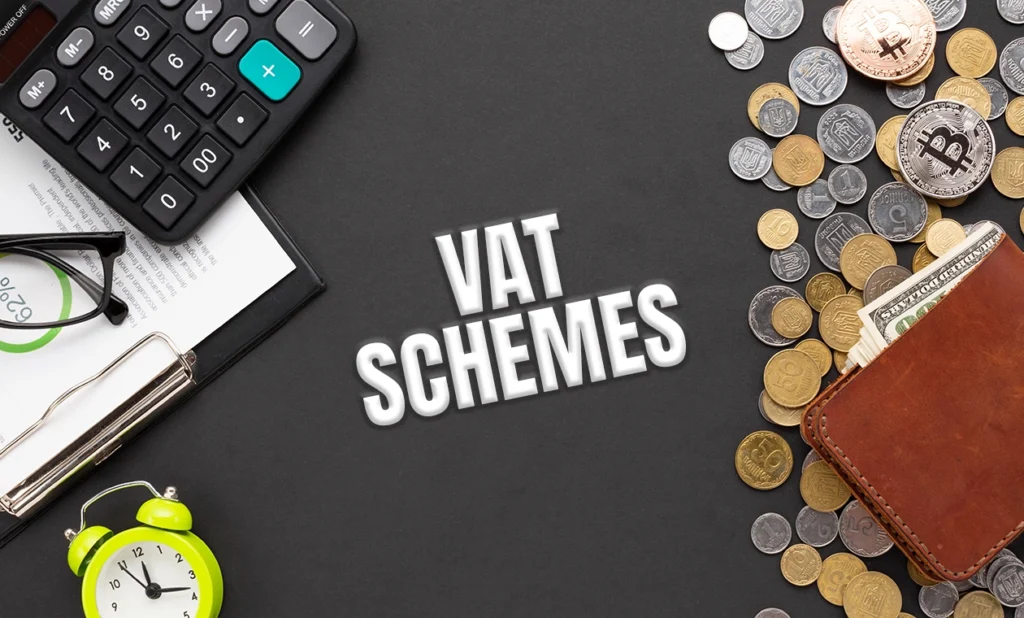Contents
As a business owner, you must be familiar with the intricacies of Value Added Tax (VAT). But are you aware that you have options regarding which VAT scheme to choose for your business? Choosing the right scheme directly impacts your cash flow, tax payments, and overall profitability.
HMRC offers 8 different VAT schemes. Each of them is designed to suit different business structures, turnover levels, and accounting methods. In this guide, we will break down eight VAT schemes available in the UK for 2024/25, explaining how they work and who can benefit the most.
Vat Schemes Explained 2024/25
Standard VAT Accounting Scheme
The Standard VAT Accounting Scheme is the default method for VAT-registered businesses in the UK. This scheme operates on the principle of cash or accrual accounting.
At the end of each quarter, businesses must calculate their total VAT liability. If the VAT collected on sales exceeds the VAT paid on purchases, the difference must be paid to HMRC. On the other hand, if the VAT paid on purchases is higher, a refund can be claimed.
The formula for calculation is as follows:
(Total VAT on Sales) – (Total VAT on Purchases) = VAT Due to HMRC (or Refund, if applicable).
Not all goods and services require VAT to be charged. If you are unsure whether your business falls under VAT exemption, check out our detailed guide here.
Who Should Use This Scheme?
This scheme works well for businesses with a steady cash flow that can comfortably manage quarterly VAT payments. It is also beneficial for companies that frequently reclaim VAT, such as those with higher business-related expenses.
However, businesses that experience delayed payments from customers can struggle with the requirement to pay VAT before receiving the corresponding revenue.
If managing VAT payments in advance strains your cash flow, you might want to consider the Cash Accounting Scheme
Specialised VAT Schemes
Whilst the Standard VAT Accounting Scheme works for many businesses, it is not always a one-size-fits-all solution. To address different business structures, cash flow needs, and industry-specific requirements, HMRC offers a range of specialised VAT schemes. These schemes are designed to simplify VAT reporting, improve cash flow management, and reduce administrative burdens.
Flat Rate Scheme
The VAT Flat Rate Scheme (FRS) offers a simplified VAT calculation method for eligible small businesses. Specifically, you can join the FRS if your anticipated VAT-inclusive turnover for the next 12 months is £150,000 or less. This turnover includes all taxable supplies, including both standard and zero-rated items, but excludes VAT itself and the sale of capital assets.
During your first year of VAT registration, you will receive a 1% discount on the applicable flat rate. For example, a marketing business might use a 10% rate instead of 11% during that initial period.
Tip: To determine if the FRS is advantageous for your business, use a VAT Flat Rate Scheme calculator and carefully evaluate your specific circumstances.
You apply a fixed percentage (set by HMRC, varying by sector) to your gross turnover to calculate your VAT liability.
Key points:
- First-year VAT registration discount: 1% off the applicable flat rate.
- Eliminates reclaiming VAT on most purchases.
- “Limited Cost Trader” rule.
- Use a VAT Flat Rate Scheme calculator to assess suitability.
What is the Limited Cost Trader Rule?
If your VAT-inclusive costs on goods are less than 2% of your VAT-inclusive turnover, or less than £1,000 per year, you will be classified as a limited cost trader. Then, you must use a flat rate of 16.5%. This rule is designed to prevent businesses from gaining an unfair advantage.
VAT Annual Accounting Scheme
The Annual Accounting Scheme allows VAT-registered businesses to simplify their VAT reporting and payment process. Instead of dealing with four VAT returns a year, you manage one, and spread your payments throughout the year. It is important to note that the payments are estimates, and that there will be a final payment, or refund, when the final return is submitted.
However, to maintain a steady flow of payments to HMRC, businesses make regular advance payments throughout the year, either monthly or quarterly.

Eligibility
To join the scheme, your estimated VAT-exclusive turnover for the next 12 months must not exceed £1.35 million. You must also maintain up-to-date VAT returns and payments, and not have been subject to insolvency proceedings.
If your VAT-exclusive turnover exceeds £1.6 million, or if you no longer meet the eligibility criteria, you must leave the Annual Accounting Scheme.
Cash Accounting Scheme
The Cash Accounting Scheme allows businesses to account for VAT based on actual payments received from customers and payments made to suppliers, rather than on the invoice date. This scheme improves cash flow, as you only pay VAT on invoices that have been paid.
This scheme is particularly beneficial for businesses with long payment cycles or those experiencing cash flow challenges.
Eligibility
To join, your estimated VAT-exclusive turnover for the next 12 months must not exceed £1.35 million. You must also have submitted all required VAT returns and have arrangements in place with HMRC to settle any outstanding VAT debts.
Potential Drawbacks
- If you switch from accrual accounting to cash accounting, you will experience a delay in VAT payments due to outstanding invoices.
- Whilst it simplifies cash tracking, it does not provide a complete picture of business performance. This can be a concern for lenders requiring GAAP-compliant financial statements.
- Capital allowances for vehicles still require adjustments if the simplified mileage rate is not used.

VAT Retail Schemes
VAT Retail Schemes are designed to simplify VAT calculations for businesses that make a large volume of retail sales. Instead of calculating VAT on each individual transaction, these schemes offer alternative methods according to the specific needs of retailers.
Here’s a breakdown of the common retail schemes:
Point of Sale Scheme
This one is the most straightforward retail scheme. You calculate and record the VAT due at the point of sale, using your electronic point of sale (EPOS) system or till records.
This scheme is ideal for businesses with modern till systems that can easily track VAT on each sale.
Apportionment Scheme
The Apportionment Scheme is designed for retailers who sell a variety of products with different VAT rates. Instead of recording the VAT on each individual sale, businesses using this scheme divide their total sales into groups based on those VAT rates.
These groups are created using representative samples or calculated proportions, which simplifies the VAT calculation process.
This method is particularly useful for retailers with a wide range of goods, where tracking VAT on every item would be overly complicated.
Direct Calculation Scheme
The Direct Calculation Scheme allows retailers to calculate their VAT liability based on their purchase records. Businesses using this scheme use their purchase invoices and stock records to determine the VAT owed on their sales.
This approach is beneficial for businesses that maintain detailed purchase records, especially when tracking individual sales is difficult or impractical.
By focusing on the purchase side of the business, retailers can streamline their VAT calculations and ensure compliance whilst reducing administrative effort.
VAT Margin Scheme
The Margin Scheme VAT allows businesses selling certain second-hand goods, art, antiques, and collectibles to pay VAT on their profit margin, rather than the full selling price. This scheme is optional and designed to prevent double taxation on the sale of these items.
The VAT rate applied to this margin is 16.67% (one-sixth). VAT is calculated on the difference between the price you paid for the item and the price you sold it for.
Standard VAT vs. Margin Scheme
If you do not use the Margin Scheme, standard VAT rules apply. Then, you charge VAT on the full selling price and can reclaim VAT on your purchase price.
The Margin Scheme is beneficial when you purchase goods where no VAT was charged, meaning you cannot reclaim any input VAT. In these cases, the margin scheme replicates the effect of normal VAT accounting.
It allows you to only pay VAT on the value you add, rather than the total sale price.
Capital Goods Scheme
The Capital Goods Scheme (CGS) is a mechanism for adjusting the amount of input VAT claimed on the purchase of a certain amount of capital assets. This adjustment is based on the asset’s taxable use over a specific period, either five or ten years, depending on the asset type. The CGS primarily applies to businesses that are partially exempt from VAT.
The term ‘capital items’ in the legislation covers both physical goods and services, not just tangible products. This includes standard-rated construction services purchased, in addition to completed buildings.
Adjustment Periods
Generally, capital items under the VAT Capital Goods Scheme are subject to adjustments over a five-year period. However, for land and buildings, the adjustment period is ten years.
Once the applicable adjustment period has concluded, there are no further obligations under the scheme.
Capital Goods Scheme Record
Businesses must maintain a Capital Goods Scheme Record for each property, containing sufficient information to determine any required adjustments.
This record must document all VAT incurred on acquiring or developing the property for the duration of the adjustment period, along with details of the VAT periods in which these costs were recovered.
This record must be kept whether or not the VAT was recoverable.
Reverse Charge VAT Scheme
The main aim of the reverse charge is to prevent fraudulent VAT activities, where suppliers charge VAT but do not remit it to HMRC. It is particularly relevant to the construction industry. This scheme shifts the responsibility for accounting for VAT from the supplier to the customer.
Instead of the supplier charging and paying VAT to HMRC, the customer accounts for the VAT on their own VAT return.
Compliance Considerations
Businesses must carefully determine if their supplied or received services fall within the scheme’s scope. This involves understanding the implications for billing and revenue.
Customers will need to inform suppliers of their VAT status.
For important updates and detailed guidance specifically for contractors and subcontractors, read our article: VAT Reverse Charge: Important Updates Contractors and Subcontractors Need To Know
FAQs About VAT Schemes
Which VAT scheme is best for small businesses?
Small businesses often benefit from the Flat Rate Scheme due to its simplified reporting, or the Cash Accounting Scheme, which helps with cash flow by only paying VAT when customers pay.
Can I switch between VAT schemes?
Yes, businesses can switch VAT schemes if they meet the eligibility criteria. However, some schemes require you to notify HMRC before making the switch.
How does the VAT Flat Rate Scheme differ from the Standard VAT Scheme?
The Flat Rate Scheme simplifies VAT reporting by applying a fixed percentage to turnover, whilst the Standard Scheme requires tracking VAT on each transaction.
What happens if my turnover exceeds the VAT scheme threshold?
If your turnover surpasses the eligibility limit for a specific VAT scheme, you must transition to an appropriate scheme or the standard VAT accounting method.
Are VAT schemes mandatory, or can I opt out?
VAT registration is mandatory if your taxable turnover exceeds £90,000 (as of 2024/25). However, choosing a specialised VAT scheme is optional, based on what works best for your business.
Choose the Right VAT Scheme for Your Business
Each of these VAT schemes is designed to simplify the VAT process, especially for small businesses. However, choosing the right one depends on your business structure, cash flow, and long-term financial goals. If you are unsure which scheme (or combination of schemes) best suits your needs, seeking professional advice from Legend Financial’s VAT specialists.
Get in touch today for a consultation and take control of your VAT strategy with confidence!










